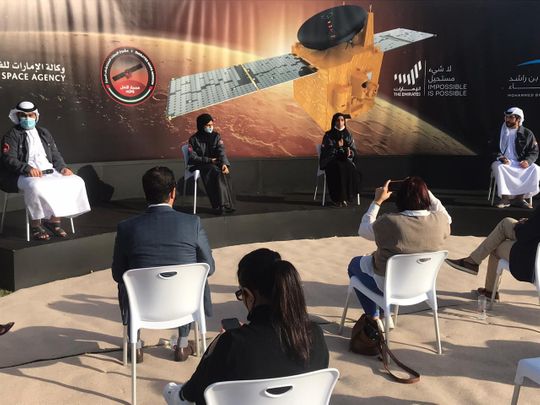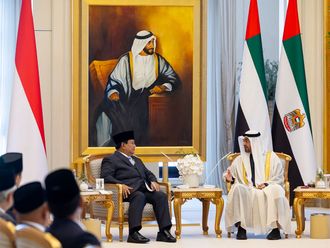
Dubai: All eyes are on the UAE Hope Probe’s crucial Mars Orbit Insertion (MOI), which is scheduled to take place on Tuesday. If successful, the UAE will become only the fifth country or entity in the world to reach Mars and the third country to achieve the feat on its first attempt.
However, it will only be by September that the first set of data captured by Hope Probe of Martian atmosphere will be released to the science community and the public, Omran Ahmed Al Hammadi, Science Data Centre Lead — Hope Probe, told Gulf News during a press briefing at the Mohammed bin Rashid Space Centre (MBRSC) over the weekend.
Al Hammadi explained: “After Hope Probe’s successful orbit entry, scientists and engineers will spend two months testing the spacecraft and its on-board scientific instruments before the orbiter will transition to its science orbit.” For two months, Hope Probe will be in capture orbit, where the spacecraft will be at its nearest point or periapsis with Mars surface at a distance of 1,000km and apoapsis or farthest point at 49,380km. During this stage, the ground control at MBRSC will conduct Three Transition to Science (TTS) manoeuvres to move the probe from its capture to science orbit. The final number of such manoeuvres will be defined by the accuracy/success of MOI. The transition to Hope’s science orbit will be completed by April 2021.
“Hope Probe has a planned 20,000km-43,000km elliptical science orbit, with an inclination to Mars of 25 degrees. In this orbit, the probe completes one orbit of the planet every 55 hours and will capture a full planetary sample every nine days,” Al Hammadi added.
30 minutes to process data
He continued: “The mission operation centres at different ground stations spread around the world will receive raw data from the Hope Probe, which will be submitted to the Science Data Centre at MBRSC, where data processing, management and indexing will be done to generate high level of scientific products before sharing with the world for free. It will take 30 minutes to process the data and the first set of data will be released by September and every three months thereafter.”
Hope Probe, with its three scientific instruments, will map a complete portrait of the Martian atmosphere and collect more than one terabyte (1,000GB) of new data.
Full picture of Mars atmosphere
There are spacecrafts currently orbiting Mars, but they only follow paths around its equator and they can only see a particular area of the planet’s surface at one time of the day. Hope Probe, on the other hand, will circle the equator, allowing it to get a complete picture of the planet every nine days — including every spot on the surface at every time of day.
The spacecraft carries three main scientific instruments that will allow it to observe Mars’ atmosphere in wavelengths from infrared to ultraviolet. “This will provide a complete view of Mars atmosphere and this will allow scientists to study how the different layers of the atmosphere interact with one another and how those interactions change depending on the time of day, season and year. This will help us answer the long-standing question of how hydrogen and oxygen escape from the Martian atmosphere and float away into space,” noted Hessa Rashid Al Matroushi, Hope Probe Deputy Project Manager — Science.
By studying the connection between current Martian weather and the ancient climate of the Red Planet, scientists will have deeper insights into the past and future of the Earth as well as the potential for human settlement on Mars and other planetary objects. Scientists will understand the weather and learn how Mars lost some of its atmosphere over billions of years of its planetary history.
How Hope Probe is different from other Mars missions
In an interview with Gulf News, Dr Nidhal Guessom, professor of Physics and Astronomy at the American University of Sharjah, said: “Hope Probe is an orbiter and will study Mars from high above its surface to give it a large field of view and the ability to observe and measure conditions everywhere on the ground and in the atmosphere, hour by hour, and day by day, throughout the Martian year (equivalent to almost two Earth years). This has not been done before.
Hope Probe carries a high-resolution digital colour camera, complemented by spectroscopes in Infra-Red and Ultra-Violet. All this will give us a complete picture of the evolution (in time and space) of the surface conditions (e.g. dust storms) and the atmospheric processes (interaction of the layers of the atmosphere and escape of various chemical elements). After a Martian year (two Earth years) of measurements, Hope will have provided great additions to our scientific knowledge of the Red Planet.
Read more
- Abu Dhabi Yas Island turns red in anticipation of UAE's Hope Probe reaching Red Planet
- MBRSC: UAE’s Hope Probe set to enter most critical phase of its Mars Mission
- This is how Emirati engineers are preparing for Hope Probe arrival in Mars
- UAE’s Hope Probe set to enter Mars orbit at 7.42pm on Tuesday
What’s next for the UAE
The UAE has already announced two important additional space projects: the second phase of the astronaut program (to send Emirati astronauts to the International Space Station to conduct various experiments) and the Lunar Rover to be send to the moon in 2024. With Hope, this constitutes a diverse and ambitious space program. According to Prof Guessom, another avenue to consider is the construction of a space rocket launch facility. “The UAE is geographically very well positioned for such launches (good latitude, sea and ocean to the east, etc.), and could become a hub for launches.”











